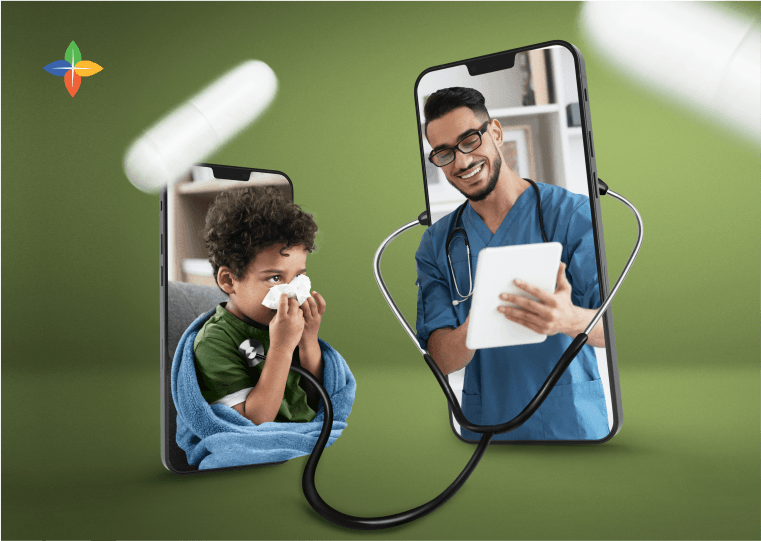The Rise of Telemedicine: A Closer Look at Virtual Healthcare
By:

Apex Hospitals
11-12-2023 5 Min Read

Telemedicine has emerged as a revolutionary force in the healthcare industry, transforming how patients and healthcare providers interact. Telemedicine is also called telehealth, evisits, e-health, or mhealth (m is for mobile). With technological advancements, telemedicine has gained significant traction, offering numerous benefits and opportunities for patients and healthcare professionals. By telemedicine, individuals can access medical care remotely, bridging geographical barriers and providing convenient and efficient healthcare solutions. This article will explore telemedicine's importance and impact on the healthcare industry.
The benefits of telehealth for patients and healthcare providers
Telemedicine has brought a multitude of advantages to patients and healthcare providers alike. For patients, the convenience of accessing medical care from the comfort of their own homes is invaluable. Telemedicine eliminates the need for lengthy commutes, waiting room delays, and the hassle of scheduling appointments. Patients can now consult with healthcare professionals through video calls, receive diagnoses, and even have prescriptions sent directly to their pharmacy, all with just a few clicks.
Furthermore, telemedicine has enhanced access to care for individuals living in remote areas or underserved communities. Patients who previously struggled to reach medical facilities due to distance or lack of transportation can now receive prompt and quality healthcare through telehealth services. This has proven to be a game-changer, particularly for those in rural regions with limited access to specialized medical expertise.
Telemedicine has effectively bridged the gap between patients and healthcare professionals, ensuring everyone has an equal opportunity to receive the care they need.
For healthcare providers, telemedicine has streamlined their workflow and improved efficiency. With the ability to conduct virtual consultations, doctors can see more patients daily, reducing wait times and increasing patient satisfaction.
Moreover, telehealth platforms enable healthcare professionals to collaborate and consult with colleagues from different locations, fostering knowledge sharing and enhancing the overall quality of care. Telemedicine has revolutionized healthcare delivery, empowering patients and providers with convenient and practical solutions.
Telehealth technology and its role in providing virtual care
The success of telemedicine relies heavily on the technology that enables virtual care. The evolution of telehealth platforms and communication tools has paved the way for seamless and secure interactions between patients and healthcare providers. These technologies encompass various applications, including video conferencing, remote monitoring devices, and electronic health records (EHRs).
Video conferencing platforms, such as Zoom and Google Meet, have become indispensable tools for telemedicine consultations. They enable face-to-face communication between patients and doctors, allowing for a comprehensive assessment of symptoms and establishing a personal connection.
Additionally, remote monitoring devices, such as wearable fitness trackers and blood pressure monitors, provide real-time data to healthcare providers, enabling them to monitor patients' health remotely. This data-driven approach allows for proactive interventions and personalized care.
Furthermore, electronic health records have revolutionized patient information storage and access. With EHRs, healthcare providers can securely access patients' medical histories, test results, and treatment plans, eliminating the need for physical paperwork and ensuring continuity of care. These technological advancements have transformed telemedicine, providing a solid foundation for virtual care and enabling efficient and effective healthcare delivery.
How telemedicine is transforming patient-doctor communication
Telemedicine has revolutionized how patients and doctors communicate, breaking down traditional barriers and fostering a more patient-centred approach to healthcare. With telehealth, patients have increased access to healthcare providers, leading to better communication and improved health outcomes.
In traditional healthcare, patients often face challenges when reaching their doctors for follow-up questions or concerns. Phone calls may go unanswered, and in-person visits may require weeks of waiting. Telemedicine eliminates these obstacles by providing patients direct access to their healthcare providers through secure messaging systems or video consultations. Patients can now ask questions, seek clarifications, and receive timely advice, all from the comfort of their own homes.
Moreover, telemedicine promotes active patient participation and engagement in their healthcare journey. Virtual consultations allow patients to discuss their symptoms, concerns, and treatment options in a more relaxed and familiar environment. This empowers patients to take ownership of their health, leading to improved adherence to treatment plans and better health outcomes.
Telemedicine also benefits doctors by expanding their reach and enabling them to provide care beyond the confines of their physical practice. Doctors can now offer follow-up consultations, monitor chronic conditions, and provide specialist opinions, all through telehealth platforms. This saves time for patients and doctors and allows healthcare professionals to allocate their resources more efficiently.
The impact of telehealth on rural and underserved communities
One of the most significant impacts of telemedicine is its ability to bridge the healthcare gap in rural and underserved communities. In these areas, access to quality healthcare has historically been challenging due to geographical limitations and a shortage of healthcare professionals. Telemedicine has emerged as a powerful solution, breaking down these barriers and ensuring that individuals in remote regions receive the care they need.
For rural communities, telehealth offers access to specialized medical expertise that would otherwise be inaccessible. Through virtual consultations, patients can connect with healthcare professionals from urban areas, receiving diagnoses and treatment plans without needing long-distance travel. This not only saves time and money for patients but also improves health outcomes by providing timely interventions.
Underserved communities, such as low-income areas or areas with limited healthcare infrastructure, also benefit significantly from telemedicine. These communities often face challenges in accessing primary healthcare services, leading to disparities in health outcomes.
Telehealth provides a lifeline by connecting patients with healthcare providers, regardless of location or socioeconomic status. This inclusivity ensures everyone has equal access to quality healthcare, promoting equity in the healthcare system.
Challenges and limitations of telemedicine
While telemedicine brings numerous benefits, it has challenges and limitations. One of the primary concerns is the issue of patient privacy and data security. Transmitting sensitive medical information over the Internet raises concerns about data breaches and unauthorized access. To address this, telehealth platforms must adhere to stringent security protocols and encryption standards to ensure patient confidentiality.
Another challenge is the digital divide, which refers to the disparity in access to technology and internet connectivity. Not everyone can access reliable internet connections or the necessary devices for telemedicine consultations. This digital divide disproportionately affects underserved communities, exacerbating existing healthcare disparities. Efforts must be made to bridge this divide through initiatives that provide internet access and affordable devices to those who need them.
Additionally, telemedicine is not suitable for all medical conditions. Certain situations require in-person examinations, diagnostic tests, or procedures that cannot be replicated through virtual consultations. Healthcare providers must carefully evaluate each patient's needs and determine when in-person care is necessary. Striking a balance between telemedicine and traditional healthcare is crucial to ensure comprehensive and effective patient care.
The Future of Telemedicine and its Potential in Revolutionizing Healthcare
The future holds immense potential to revolutionize the healthcare landscape. As technology advances, telemedicine will become increasingly sophisticated, offering more comprehensive and personalized care solutions.
Artificial intelligence (AI) and machine learning algorithms have the potential to enhance the accuracy and efficiency of telemedicine diagnoses. By analyzing vast amounts of patient data, AI algorithms can assist healthcare professionals in making more precise assessments and treatment recommendations. This improves patient outcomes and reduces the burden on doctors, enabling them to focus on complex cases that require their expertise.
Integrating virtual reality (VR) and augmented reality (AR) technologies into telemedicine can enhance the patient experience further. VR can transport patients to virtual environments, reducing anxiety and pain during procedures. AR can overlay digital information onto the real world, assisting healthcare professionals during examinations and surgeries. These immersive technologies have the potential to revolutionize medical education and training as well, providing realistic and interactive simulations for aspiring healthcare professionals.
Telemedicine will become integral to the healthcare system, working with traditional care to provide comprehensive and accessible healthcare. Embracing telemedicine is necessary and a leap toward a healthier and more connected world.
Embrace the future of healthcare and explore the possibilities of telemedicine. To book an appointment, download our mobile application and experience the convenience and benefits of virtual care firsthand. Your health is just a click away!
FAQS
Related Articles
Connect With Us
Health In A Snap, Just One App.
KNOW MORE































































